August 2018
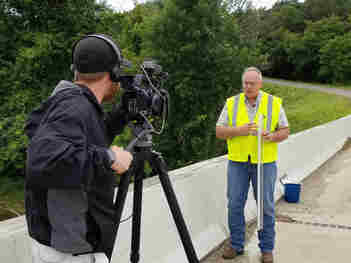
Recognizing the importance of water quality in the thousands
of lakes and miles of streams that provide habitat and recreation across the
prairie landscape, a public television station in western Minnesota has filmed
a segment on MPCA’s
citizen water monitoring programs for an upcoming program. Pioneer Public Television in Granite Falls
will be including the segment in its popular “Prairie Sportsman”
show next January.
Producer Cindy Dorn says she got the idea while browsing
featured stories on the MPCA website. She found one about a “fishy
surprise” for a citizen lake monitor. It told of a volunteer monitor who
noticed a lot of empty beverage cans along the lakeshore. Upon further
inspection, she discovered bullhead fry trapped inside the cans.
Cindy contacted MPCA about other possible citizen monitoring story ideas for
Prairie Sportsman. On July 26 videographers went to a Hawk Creek monitoring
site west of Granite Falls where they interviewed citizen stream monitor Brad
Froland, Hawk Creek Watershed Project technician Jordan Austin, and Forrest Peterson of MPCA. They
used a drone to capture dramatic aerial video of Hawk Creek meandering among
vast fields of corn and soybeans. Next stop was the south shore of Big
Kandiyohi Lake southeast of Willmar where they filmed citizen lake monitor
David Peterson. At both locations the volunteers were very articulate in
describing their work and its important role for water quality. Photo: Brad Froland describes a Secchi tube on camera at a bridge over Hawk Creek east of Granite Falls.
The Prairie Sportsman show dates back to 1991 and became one of the most popular
local productions of Pioneer Public Television. After a funding-shortage hiatus
in 2016, it received a grant from the Environment and Natural Resources Trust
Fund to resume new programming. Founded in 1966, Pioneer Public Television serves
southwest and west central Minnesota, northwestern Iowa, eastern South Dakota
and southeastern North Dakota. A digital, over-the-air broadcast signal and can
also be viewed in western Wisconsin and Twin Cities Metro area through Dish and
DirecTV.
Back to top
|
The third annual "Secchi Social" for citizen water quality monitors will be Thursday, Sept. 27 at Chase on the Lake, Walker. The event gathers volunteer monitors to network and hear presentations by local water resource professionals about water quality protection efforts in the region. Citizen Monitoring Program volunteers will share their thoughts and perspectives on monitoring. Volunteer speakers are encouraged to contact the MPCA. There will be recognition of five-year “Milestone” volunteers in attendance, raffle prizes, and a catered lunch. Coffee and registration 10-11 a.m., lunch and program
11 a.m.-2 p.m. A bloc of rooms has been reserved for the night of Sept. 26. An online RSVP form is due Friday, Sept. 14, or
call Laurie at 651-757-2750 or Shannon at 651-757-2874 with your attendance
information. There is no cost, and each volunteer can have one additional guest
attend. You only need to RSVP if you plan on attending.
Back to top
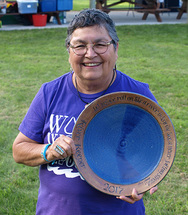 Sharon Day received the 2017 RiverKeeper award bestowed by Clean Up the River Environment (CURE) recognizing her leadership with the Indigenous People's Task Force, and "Nibi Walks." At the “Water, Women, and Democracy” event July 28 at Wegdahl County Park on the banks of the Minnesota River she shared her thoughts during a conversation about creating a Water Ethic Charter for Minnesota. The award comes with a large, ceramic plate inscribed with a verse from the book of Amos: “May justice flow like water and integrity as an unfailing stream.” Photo by Anne Borgendale.
In 2017 Sharon led a group of walkers along the length of the Missouri River in a ceremony known as a Nibi Walk. Nibi is the Anishinaabe (Ojibwe) word for water. The 2,460-mile journey began Aug. 1 at the Missouri River Headwaters State Park near Three Forks, MT and ended Sept. 22 in St. Louis.
Water walking is a modern ceremony started in 2003 by Sharon’s mentor, Josephine Mandamin of the Wikwemikong First Nation. It involves women carrying a copper pail of water from the headwaters of a river to its end while praying for the water and praying with the water. By carrying water from the beginning of the river to the end, you presumably are starting with cleaner water, and at the end of the walk, you can show the water at the end what it once was like.
Sharon has led or co-led fourteen water walks including the Chippewa River, Cuyahoga River, James River, Kettle River, Minnehaha Creek, Minnesota River, Mississippi River, Ohio River, Pokemaga Lake, Potomac River, St. Louis River, Seneca Lake, Mother Earth Water Walk (from the Gulf of Mexico to Lake Superior), and, the longest river in the United States, the Missouri River. On Aug. 4 Sharon started leading a Nibi Walk along the Wisconsin River.
Back to top
|
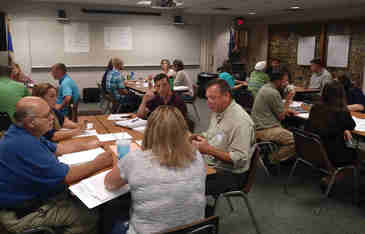 Civic engagement and public participation was a major focus during the MPCA's Middle Minnesota River Watershed Approach occurring from 2013 through 2017. The MPCA worked with county and SWCD staff in the watershed, consultants, citizens, and other state agency staff to work on eight projects to promote civic engagement collaboratively in the area. Projects were tailored to local partner interest and capacity. A report is located on the Middle Minnesota River Watershed webpage.
The Middle Minnesota Watershed Civic engagement projects were:
- Minnesota River at Mankato: Stakeholder Identification and Analysis
- Middle Minnesota Watershed Zonation Analysis
- Minneopa and Fort Ridgely Watershed Interpretive Signs
- Middle Minnesota Watershed SWCD WRAPS Strategy
- Middle Minnesota Watershed Renville County WRAPS Strategy
- Middle Minnesota Watershed Nicollet County WRAPS Strategy
- Middle Minnesota Watershed Lakes WRAPS Strategy
- Lake Hallett Civic Engagement Project
Back to top
|
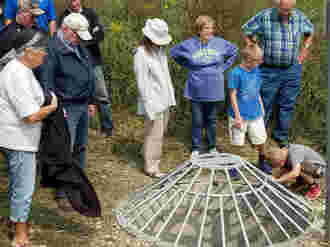 If a lake draw-down project works as intended, Diamond Lake in Kandiyohi County east of Willmar could see a return of some water quality lustre. Instead of draining nutrient-rich water into Diamond Lake, a chain of three nearby shallow lakes will have a draw-down intended to improve their water quality and habitat, and flow reversed away from Diamond. While less than half of Diamond Lake's watershed, the three nearby lakes contribute about 75 percent of the phosphorus load to Diamond.
On Aug. 22 state and local partners behind the project and guests toured the Hubbard, Wheeler, and Schultz lakes management project. It started in 2010 with Ducks Unlimited and Middle Fork Crow River Watershed District. Working with the DNR and local landowners, the project received Outdoor Heritage Funds complemented by funds from the MFCRWD and DU. Three water control structures are installed between the lakes, and a large subsurface pipe provides outflow. Total cost was nearly $800,000. The lakes are expected to reach full draw-down this winter. It will help remove rough fish and improve aquatic plants. Natural recharge will begin next spring. According to the DNR it is the first draw-down project to involve a chain of lakes. Photo: Tour members peer down the access to the subsurface pipe where flow from the three lakes enters a county ditch.
Back to top
|
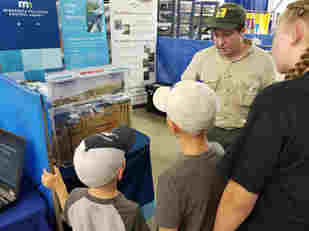 DNR staff will be near the North Fork of the Crow River Aug. 23 to demonstrate how they measure stream flow and aquifer levels. They will show how the area’s two automated weather stations gather data on precipitation, temperature, wind speed and wind direction, and relative humidity. They will talk about how that data can be used to inform groundwater flow analysis in the Bonanza Valley Groundwater Management Area, which extends roughly from Paynesville northwest to Glenwood.
Enhanced data collection and analysis is one of several key actions outlined in the Bonanza Valley Groundwater Management Area Plan. Anyone interested in learning more about that plan can visit the project web page at www.dnr.state.mn.us/gwmp/area-bv.html.
When: 10 a.m. Thursday, Aug. 23. Where: Park at the North Fork Wildlife Management Area Parking Lot, near 44697 Johnfield Road, Belgrade, 0.5 miles southeast of Big Grove Lutheran Church on Johnfield Road. The event will be at the bridge east of the parking lot. For more information contact Mark Hauck, DNR Bonanza Valley Groundwater Management Area project manager, 320-223-7846, Mark.Hauck@state.mn.us. Photo: DNR groundwater protection hydrologist Ari Berland demonstrates a groundwater model at the Kandiyohi County fair.
Back to top
|
A series of free webinars will
be offered live on the WaterWay Network to share the latest research from the Discovery Farms programs
of Wisconsin and Minnesota. All webinars will begin at noon. The first occurred Aug. 21,
Edge-of-field
water quality in two Wisconsin watersheds
with Amber Radatz, UW
Discovery Farms co-director. Certified crop consultants will be eligible to receive CEU credits per each webinar attended. Recordings of the webinars will be available online. Register. Questions? Contact Erica.olson@ces.uwex.edu. Remaining webinars:
- Aug. 28:
Benchmarking
Nitrogen Use Efficiency,
Matt Ruark,
UW-Madison Dept. of Soil Science;
Abby Augarten, UW Discovery Farms NUE coordinator.
- Sept. 4:
Lessons learned
from Spring Creek Farms,
Tim Radatz, director, Discovery Farms Minnesota.
- Sept. 11:
Digging deeper
into soil health,
Matt Ruark,
UW-Madison Dept. of Soil Science, Greg Richardson, recent masters graduate from the UW-Madison Dept. of Soil Science and Agroecology.
Back to top
Friends of the Minnesota Valley is seeking a coordinator for a River Watch program in the Minnesota River basin. With funding from LCCMR, Friends operated a limited test program during the 2017-2018 school year and is now taking it basin-wide. They are seeking a half-time coordinator to finish planning and lead the program for this coming school year and the next year.
The ideal candidate would have a knowledge or strong interest in water quality improvement and can work well with teachers, school administrators, and students. The coordinator would: Oversee the program including accompanying school teams to conduct monthly water quality monitoring, communicate with school districts and Friends of the Minnesota Valley on progress, contact high schools for involvement goal of 20 teams, engage with the International Water Institute and any national organizations that have experience with citizen water, meet with MPCA to review requirements for logging and submission of data, create an annual monitoring report.
Back to top
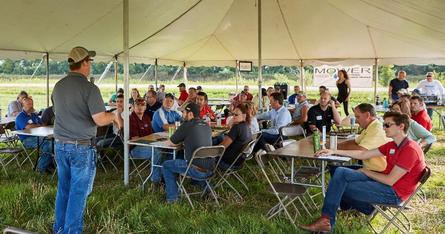
Farmers in the Cedar River Watershed gathered
Aug. 17 at the Justin Krell farm to learn from local experts how maximizing soil health can
economically benefit their operations while protecting water quality. The Cedar River Watershed Partnership
organized the event for dozens of farmers in the watershed and surrounding
region at the Krell farm near Blooming Prairie, the upper part of the Cedar
River Watershed. CRWP photo: Justin Krell speaking to group.
Aimed at increasing farmers’ knowledge of soil
health practices, particularly tillage and cover crops, the field day focused
on the costs and benefits of adopting different land-management practices that
improve the soil, water and economic health of farms. Local agricultural
retailer Central Farm Service (CFS) provided a field demonstration to showcase
different tillage methods and the associated profitability, yield, and soil
health. Keynote speakers included Bert Strayer, a cover crop expert with La
Crosse Seed who shared his deep experience of integrating cover crops into a
profitable farm management strategy, and Steve Lawler, a soil scientist with
Mower County Soil & Water Conservation District (Mower SWCD) who
demonstrated how healthy soil can help with water retention and mitigate
intense rain events.
The partnership shared with
farmers how to increase agricultural productivity and profit while also
protecting and improving local water resources through a panel discussion
moderated by Hormel Foods. Partners encouraged farmers in the watershed to
contact and work with partners like CFS, the Mower SWCD, and Land O’Lakes
SUSTAIN to pursue information, services and resources that help them adopt
practices that are the most effective and practical for their operation. - CRWD news release
Back to top
|
U of M receives funds for soil and manure research
The University of Minnesota receives two USDA Conservation Innovation Grants (CIG) to expand soil health and manure management research and outreach for our cold climate soils. The Water Resources Center will receive $885,000 to support work at the Minnesota Office for Soil Health, along with partners across the state, to fill the gap in data and case studies about soil health management in cold climates.
The grant will support monitoring of soil health properties across Minnesota, a public database to analyze and share soil health measurements, and a web portal and field events to facilitate farmers and agricultural advisors learning from each other.
Melissa Wilson, Extension Manure Management and Water Quality Specialist, was awarded $125,000 to develop and demonstrate best management practices for the integration of cover crops and manure injection, an innovative approach that can potentially optimize soil nutrient cycling and improve soil health when properly implemented. A list of all CIG awards is available on the USDA website.
Lower Red-Tamarac rivers watershed reports on public notice
The Lower Red River-Tamarac Watershed TMDL and WRAPS reports
are on public notice Aug. 13-Sept. 12. The reports are posted on the Lower
Red River-Tamarac Watershed web page. The
public notice for these reports was published in the State
Register on Aug. 13 and is posted on the MPCA Public Notice web page. The Draft/pending
projects web page has been updated with the public notice dates. The Lower Red River of the North
Watershed (HUC 09020311) is located in the far northwestern portion of
Minnesota in portions of Kittson, Marshall, and Roseau counties. Land use is predominantly agricultural, comprising 80% of the landscape.
The focus of this report is be on the tributaries, which flow
to the main channel of the Red River of the North (Red River). Two listed
impairments (1 caused by a poor aquatic macroinvertebrate community and the
other caused by a poor fish community) on the same reach are addressed in the TMDL report using one total suspended solids (TSS) TMDL study.
Registration open for Hypoxia Task Force public meeting and webcast Sept. 18
A free webcast of the Gulf of Mexico Hypoxia Task Force public meeting will be 9 a.m.-noon, Wednesday, Sept. 18. The meeting will be at the Hilton Baton
Rouge Capitol Center in Baton Rouge, LA. Visit https://water-meetings.tetratech.com/Hypoxia/StaticPublic/index.htm
to register, find meeting and location information, and download the meeting
agenda and other materials. For questions contact:
Yishen Li at Li.Yishen@epa.gov, or Katie
Flahive at Flahive.Katie@epa.gov.
Back to top
|